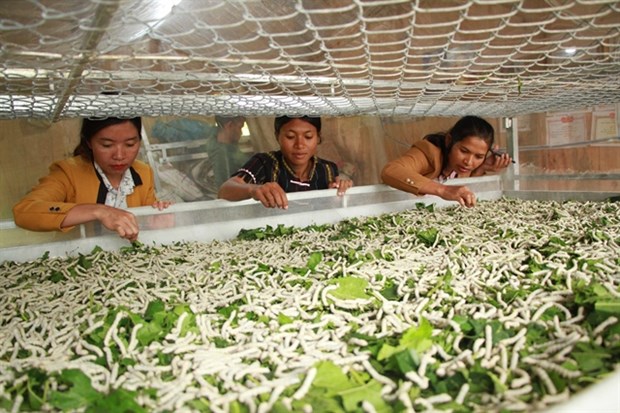Lam Dong sericulture farmers find livelihoods steady
Increasing the sericulture area is optimal for restructuring agriculture in Lam Dong province since it provides farmers with a steady income, local officials said.
 Illustrative image (Photo: VNA)
Illustrative image (Photo: VNA) Lam Dong (VNS/VNA) - Increasing
the sericulture area is optimal for restructuring agriculture in Lam Dong province
since it provides farmers with a steady income, local officials said.
The Central Highlands province has around 14,000 sericulture farming households who have total 6,800ha of mulberry, or nearly 70 percent of the country’s total, according to the province’s Department of Agriculture and Rural Development.
Lam Dong produces around 9,000 tonnes of silkworm cocoons a year to produce nearly 1,200 tonnes of silk.
K’ Tieu, a Co Ho ethnic minority in Lam Ha district’s Dinh Van town, has turned his 4,000sq.m rice field and 2,000sq.m coffee plantation into mulberry farms to breed silk worms.
He earns more than 12 million VND (517 USD) a month from selling cocoons, he said.
“Growing mulberry and breeding silk worms do not need much investment or tending like coffee and rice, and they can be harvested in a short time.”
Dinh Van town has favourable natural conditions for sericulture, and so local authorities have provided training to farmers and financial support to grow mulberry and breed silkworms.
A 1,000sq.m mulberry farm can provide enough leaves for breeding silkworms hatched from one box of eggs containing 15-25 grams of the eggs, enough to produce 50kg of cocoon.
It takes around 24 days from hatching to producing cocoons.
K’Bin, deputy chairman of the town's Farmers Association, said previously most Co Ho people used to grow rice and coffee, but Dnh Van’s soil is not suitable for coffee and only one rice crop could be grown a year.
“With the State’s support in terms of farming techniques and seedlings, many Co Ho people have abandoned coffee and rice, and switched to growing mulberry and breeding silkworms.”
Nearly 1,000 Co Ho households have made the switch.
In Di Linh district, one of the province’s largest mulberry growing areas, many ethnic minority households have steady incomes from breeding silkworms.
K’ Xuyen, an agricultural official in the district’s Gia Nghia commune, said the commune has sought economic development for ethnic minority areas in recent years by focusing on sericulture.
“Sericulture [provides an] income year round. The income enables families to plant long-term crops and breed animals.”
The commune has hundreds of ethnic minority households growing mulberry and breeding silkworms on an area of 200ha, he said.
Silk processors now buy cocoons at 130,000-150,000 VND (5.6-6.5 USD) per kilogramme and farmers earn 30,000-50,000 VND per kilogramme, according to agricultural officials.
Under the five-year plan for sericulture it unveiled in June, the province aims to have 9,500-10,000ha under mulberry, including 8,100-8,500ha of new and hybrid trees with high yields, by 2023./.
The Central Highlands province has around 14,000 sericulture farming households who have total 6,800ha of mulberry, or nearly 70 percent of the country’s total, according to the province’s Department of Agriculture and Rural Development.
Lam Dong produces around 9,000 tonnes of silkworm cocoons a year to produce nearly 1,200 tonnes of silk.
K’ Tieu, a Co Ho ethnic minority in Lam Ha district’s Dinh Van town, has turned his 4,000sq.m rice field and 2,000sq.m coffee plantation into mulberry farms to breed silk worms.
He earns more than 12 million VND (517 USD) a month from selling cocoons, he said.
“Growing mulberry and breeding silk worms do not need much investment or tending like coffee and rice, and they can be harvested in a short time.”
Dinh Van town has favourable natural conditions for sericulture, and so local authorities have provided training to farmers and financial support to grow mulberry and breed silkworms.
A 1,000sq.m mulberry farm can provide enough leaves for breeding silkworms hatched from one box of eggs containing 15-25 grams of the eggs, enough to produce 50kg of cocoon.
It takes around 24 days from hatching to producing cocoons.
K’Bin, deputy chairman of the town's Farmers Association, said previously most Co Ho people used to grow rice and coffee, but Dnh Van’s soil is not suitable for coffee and only one rice crop could be grown a year.
“With the State’s support in terms of farming techniques and seedlings, many Co Ho people have abandoned coffee and rice, and switched to growing mulberry and breeding silkworms.”
Nearly 1,000 Co Ho households have made the switch.
In Di Linh district, one of the province’s largest mulberry growing areas, many ethnic minority households have steady incomes from breeding silkworms.
K’ Xuyen, an agricultural official in the district’s Gia Nghia commune, said the commune has sought economic development for ethnic minority areas in recent years by focusing on sericulture.
“Sericulture [provides an] income year round. The income enables families to plant long-term crops and breed animals.”
The commune has hundreds of ethnic minority households growing mulberry and breeding silkworms on an area of 200ha, he said.
Silk processors now buy cocoons at 130,000-150,000 VND (5.6-6.5 USD) per kilogramme and farmers earn 30,000-50,000 VND per kilogramme, according to agricultural officials.
Under the five-year plan for sericulture it unveiled in June, the province aims to have 9,500-10,000ha under mulberry, including 8,100-8,500ha of new and hybrid trees with high yields, by 2023./.













